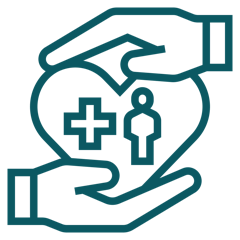What is a community health worker?
Community health workers, or CHWs, can go by many different job titles, including patient care navigator, outreach worker, lifestyle coach, peer aide, support specialist, community health representative— the list goes on2,3. But despite differences in title, there are several commonalities under the umbrella of community health worker jobs.
According to the Centers for Disease Control and Prevention, community health workers are trained public health workers who serve as a bridge between communities, healthcare systems, and state health departments4. You can think of them as the “glue” of healthcare service delivery– they fill in the gaps between health care services, providers and patients in their communities. CHWs often share cultural, linguistic, or lifestyle similarities with the people they serve, like these Los Angeles-based CHWs that support justice-involved individuals with re-entry5. This combination of health training and local knowledge is ideal for improving community education, connecting people to health interventions, and reducing health disparities among vulnerable populations.
What are common responsibilities and duties of community health workers?
In 2007, the US Department of Health and Human Services conducted the Community Health Worker National Workforce Study, which is the only comprehensive national survey on CHW services6. This survey identified the most common work activities of CHWs, which include:
Health Education and Outreach: CHWs work to educate patients, providing vital information on preventive measures, healthy behaviors, and available health care resources. Common tasks include conducting workshops, preparing presentations, providing informal counseling to community members, and disseminating educational materials.
Individual Assessment: They also help assess the health needs of individuals. Their duties can involve conducting health screenings, collecting some forms of health data, identifying barriers to care, and creating personalized plans to address those needs.
Care Coordination: CHWs collaborate with healthcare providers to assist individuals in navigating the healthcare system. This can include scheduling appointments, ensuring follow-up on treatment plans, and promoting communication between different heath care providers.
Advocacy and Social Support: Community health workers advocate for the rights of community members to access quality health services. They offer emotional support and empower them to overcome challenges in the healthcare landscape. They can also support patients in accessing social services, such as health benefits, health insurance, federal income assistance, and culturally tailored support services.
Collaboration: In order to fulfill their day-to-day tasks, CHWs work in close collaboration with various stakeholders. Collaborators typically include:
Healthcare Professionals: CHWs collaborate with doctors, nurses, social workers, and case managers to ensure coordinated and holistic care for individuals. They act as liaisons between patients and providers by sharing information, providing updates, and facilitating referrals.
Community Leaders and Organizations: CHWs collaborate with community leaders, policymakers, and local organizations to advocate for health equity, develop community-specific strategies, and foster partnerships that enhance access to healthcare resources.
What are not common responsibilities and duties of community health workers?
While CHWs are vital contributors to community health, there are certain tasks that fall outside their scope of practice. It is important to understand these limitations, which typically include direct medical treatment, diagnosing illnesses, and prescribing medications. CHWs are not primary care providers. These duties are reserved for trained and licensed healthcare professionals like doctors and nurses, and CHWs work in collaboration with these professionals to ensure individuals receive appropriate medical care. Under proper guidance and training, they may assist with administering some services, like blood pressure screening and first aid2.






